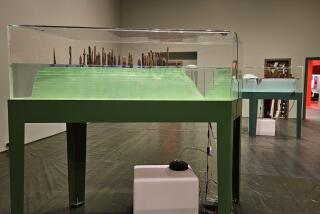From PVC Tubing to Ice, Art Takes Form
- Share via
MILAN, Italy — According to designer Paolo Ulian, the Salone Satellite orbiting the vast solar system of the Salone 2001 Fair is like a Trojan horse that allows adventurous young designers to ride incognito into the institutionally oriented furniture show. It is a vital opportunity for emerging designers to showcase their talents to the legends of their profession as well as the manufacturers who have the powers to place their design solutions on the map.
Whatever the trends exposed by the commercial sector of the fair--be it brightly colored rectilinear sofas or sleek rethinkings of modernist designs--the designers in the Satellite seemed to be most interested in the exploration of materials and the conceptual process.
Making clever use of PVC tubing, Belgian designer Mathias Claerhout wound a garden hose of small lights around a rotating drum that could be unwound to extend the lighting over as much distance as necessary.
In a more artisanal spirit, “designer by profession, housewife by vocation” Italian Anna Citelli worked by hand in her home, knitting PVC tubing into small, translucent sweaters that she delicately hung from metal hangers and internally illuminated with 100-watt fluorescent bulbs, eliminating the need for an industrial sponsor.
London-based Japanese designer Yamanaka resolved the problem of seating and lighting in one object, creating the luminous “How Slow the Wind” swivel chair with its light source embedded within its glowing base.
At the extreme end of domestic utility, a pair of brothers from Turin--Gabriele and Davide Adriano--created brightly covered plastic trays made in the form of toilet seats. Designed to fit over the bidet, they turned the toddler-height faucet into a place for children to brush their teeth.
With a conceptual take on the problem of how to showcase their talents, the always humor-minded Design Raw group from San Francisco drew a long line with the witty “Design Confessional,” a computerized reduction of the design process. The confessor was prompted to accept or reject a series of six basic forms appearing on a computer screen. At the end of the series, the computer spit back a set of all the possible designs created from these blind choices.
At the very least, Nucleo Global Design Factory of Turin seemed to have mastered one of the undeniable problems of the marketplace: how to be heard above the din. Lining the walls with “units of creativity,” which looked like IV pouches, Nucleo presented a collection of sleekly designed molded-ice furniture that was progressively melting under the pavilion’s lighting. Asked about such unfashionable notions as producing commodities to pay the rent on their studio space, a Nucleo spokesman explained the potential for industrial production of their ice furniture--means of delivery permitting. It might be paired with a product they currently have in distribution--a grass chair grown from a kit that could be watered by the ice as it melts.
More to Read
The biggest entertainment stories
Get our big stories about Hollywood, film, television, music, arts, culture and more right in your inbox as soon as they publish.
You may occasionally receive promotional content from the Los Angeles Times.










